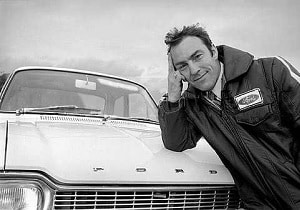
Article: Footballers Who Participated & Excelled at Other Sports
Home ⇒ Articles
By Brian Beard | 23rd MAR 2020
There may be an absence of football matches at present but there is no shortage of footballers, over the past century and a half who did more than kick a football for club or country, or both. The early years of our national game were littered with players who played cricket, rugby and football, sometimes all three but generally it was two out of three which isn`t at all bad.
William Gunn was one such player and although he may not be a name that trips of the tongue as readily as Greaves, or Hurst, Kane or Rooney he not only played international football and cricket but he also played a significant part in one of the early rule changes in football that is with us today.
`Billy` as he was known played football for Nottingham Forest and Notts County, in the 1880s. He also played for Nottinghamshire County Cricket Club and between 1880 and 1904 he played 11 test matches for England. Tall and athletic `Billy` was one of the players in the Victorian era who had an extra string to his bow, so to speak, quite appropriate for a Nottingham-born lad.
He could, from a throw-in, hurl the ball fully 80 yards because in those days it was within the current laws of the game to use a one-handed throw. He wasn’t the only one but was perhaps the most well-known. However, in an England –Scotland game in 1882 the Scots were so terrified of the effect such long throws were having on their team they protested. So much so that the following year the Football Association changed the rules that introduced the two-handed throw in we have to this day.
CB Fry was another Victorian sportsman who was such a great all-round performer that if he had lived today he would have been a DC Superhero. Not only did he play international football and cricket for England he was also the holder of the world long-jump record. He played for Southampton in the 1902 FA Cup Final and played nearly 400 first class cricket games and played in 95 Test Matches. His batting average, in a career total of more than 30,000 runs was an impressive 50. He was also, allegedly, at one point, offered the vacant throne of Albania, with an annual salary of £10,000 but turned it down.
Football and cricket grew in intensity as the 20th century wore on and there were fewer players who had the time, inclination or the ability to see their football season merge into the cricket season but no such problem for Denis Compton.
Denis spent his entire cricket career with Middlesex and won 78 caps for England scoring nearly 39,000 runs for a 51.85 average. He also managed to play for Arsenal, between 1936 and 1950 though the Second World War restricted his record to just 54 appearances. Despite prodigious football ability Denis was, like so many footballers, badly affected by the war and despite the fact he appeared in a dozen wartime internationals he never gained a peacetime cap and so is not, officially, recognised as an England international though he clearly was of international standard. He is also one of the last footballers to play international cricket and football for his country.
Jimmy Greaves will always be regarded as a footballer occupying the very Pantheon of the game. He was the original goal-grabber and set records right left and centre forward, for club and country and is still the highest goal-scorer in English top-flight football with 357 goals. Unfortunately Jimmy will also be remembered for losing his almost guaranteed place in the England team as they were moving through the 1966 World Cup towards winning the trophy on home soil.
Jimmy was injured in the group stages of the World Cup, after being `studded` against France. His injury needed 14 stitches and Jimmy lost his place to Geoff Hurst, for the quarter-final against Argentina, and of course Geoff went on to make history with the most famous hat-trick in English football. Jimmy only played three more times for England before his final cap in 1967 and retired from international football in 1969, the year before England went to Mexico to defend their world title. Jimmy wasn`t going to go there, as a footballer, but he had other ideas. He would go to Mexico, by car, as a rally driver.
The 1970 World Cup Rally, sponsored by the Daily Mirror, had a bit of a poignant start for Jimmy because the race was started by Sir Alf Ramsey with a huge Union Jack flag. Car number 26, a black and white Ford Escort raced off from Wembley Stadium with Tony Fall alongside Jimmy. After 16,245 gruelling miles only 23 cars finished, from 96, and five days before the first World Cup game kicked off Jimmy arrived, finishing in sixth place. Graham Hill, father of Damon and an F1 champion like his son said, at the time.
“Jimmy Greaves has earned the admiration of the motoring world. It is an outstanding achievement for him to finish so high in a field against some of the greatest rally drivers in the business.”
Geoff Hurst, the beneficiary of Jimmy Greaves` ill-fortune in 1966, will be remembered for all time by virtue of his World Cup Final hat-trick. But Sir Geoff has another claim to fame that isn’t as well known because he also played first-class cricket. Okay it may not have been as productive or lengthy as CB Fry or Denis Compton but it is still there in black and white.
I was fortunate enough to interview Geoff a few years back and as we spoke we moved on to the subject of his cricket career. I made the mistake of quoting what I had researched beforehand, a score of `0` and `0` which, in cricket parlance is a pair, a “golden duck” . Sir Geoff was affronted and quite rightly so. He pointed out that his one and only appearance in First Class Cricket, for Essex against Lancashire at Aigburth, Liverpool in 1962, saw him finish with figures of, and I quote this particular knight of the realm.
`Nought, and nought, NOT OUT. I was not out in the second innings, have you got that`?
Ian Botham, arguably English cricket`s greatest all-rounder, also played professional football and enough times for no one in their right mind to regard such an achievement as a publicity stunt. He played 17 times for Yeovil between 1978 and 1980, scoring one goal, and 11 times for Scunthorpe United between 1980 and 1985.
But I leave the last word on players who have played two sports to the highest level, to one Chris Balderstone. Indeed Chris not only played cricket for Leicestershire but he also `stood` as an umpire for two ODIs. Chris played nearly 400 first-class cricket games, and two Test Matches, to amass a career total of 19,000 runs and an average of 34. Chris was such an integral part of the Leicestershire team in their glory days that by the time he picked up his sixth winners` medal, for winning the Benson and Hedge Trophy in 1985, he was the highest medal winner, with six, in the county`s history.
But the thing I really love about Chris`s story was the history he made in 1975, by taking part in a County Championship game and a Football League game, ON THE SAME DAY, with the kind of PS you couldn`t make up.
Chris scored 51 runs, for Leicestershire, against Derbyshire, at Chesterfield, by the end of the second day. At the close of play he set off for Doncaster, some 30 miles away, to play for them against Brentford. After the 1-1 draw he drove back to Chesterfield the next day, went on to complete a century, as well as taking three wickets, helping Leicestershire to their first ever County Championship title.
And there are quite a few more players who have scaled the heights of more than one sport. More on them down the road.
By Brian Beard, Associate Historian to the Football Association.



